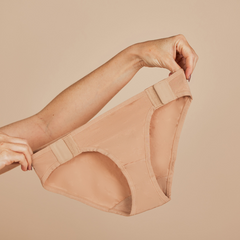We are doing an educational series on pelvic floor health and therapy with Dr. Karla Wente, PT, DPT, WCS, CLT. The benefits of pelvic floor therapy can be life-changing for women in every part and stage of life, from sexual wellness to pregnancy to peri- and post-menopause.
We hope this series empowers women to seek out the best care and improve their quality of life. This is the first of several articles, which we’ll link as they become available.
This Part 1 will cover what is pelvic floor physical therapy, the benefits of therapy, who should seek out care, and common conditions.

Nicole: What is pelvic floor therapy?
Dr. Wente: Pelvic floor therapy is a specialty of physical therapy (PT), where we address the movement and function of your pelvic floor muscles. The main function of your pelvic floor muscles is to support your pelvic organs to function as sphincters, which means opening and closing the holes. They help to prevent urinary and stool leakage, allowing you to empty fully, and allowing for sexual function. The muscles play a role in orgasm and arousal.
In physical therapy, we evaluate the pelvic floor muscles by assessing them on the outside and inside of the vagina or rectum. Specialists in pelvic floor physical therapy are specifically trained in pelvic floor muscle assessment, in addition to many years of schooling for general and musculoskeletal physical therapy. We also provide you with education about what the pelvic floor muscles do and where they are in your body. Throughout the course of therapy, we train you in how to use the pelvic floor muscles best.
Nicole: What are some of the most common conditions you see?
Dr. Wente: The main conditions I see in pelvic floor PT are urinary and fecal incontinence, and pelvic/abdominal pain. Urinary and fecal incontinence just means leaking pee or poop anywhere other than the toilet. I also see people with bowel or urinary urgency. This means that you have to go to the bathroom all the time, you can't quite make it, or you’re worried about not making it.
I also see pelvic and abdominal pain, including pain during or after sex or arousal. Back and hip pain can also be related to pelvic floor muscle pain, so it can be beneficial to see a pelvic floor PT if your back and hip pain is not improving by traditional methods.
I also treat pelvic organ prolapse, which is a condition where your organs are sagging within the pelvic cavity or even coming out of your vagina or rectum. It is a very common condition, but super distressing. So we can make a big difference in symptoms and function for people with prolapse.
Nicole: When should people seek out pelvic floor therapy?
Dr. Wente: I'd say if you're pooping or peeing when you don't want to, then you should see your pelvic floor PT. If something has changed about your bowel movements, if you feel like something’s falling out of you, if something's changed about your sex life, if you're not able to engage in sex like you used to because of pain or lack of functioning or difficulty with orgasm. Those are the big ones.

Nicole: Are there specific areas in women’s health that you treat?
Dr. Wente: Pelvic floor therapists are women's health experts. I see men, women, and children, but we typically start our training as women's health experts. So, we frequently see pregnant women, postpartum women, people after C-sections.
We do a lot of scar management. Scars should move and be pain-free after healing. If you have painful or restricted scarring after a c-section or tearing in the perineum after vaginal delivery, we can help with scar mobility.
Nicole: Why doesn’t everyone get pelvic floor physical therapy?
Dr. Wente: That's a really tricky question. Who someone can treat is a little bit different based on their practice settings. For example, I'm in private practice. We accept Medicare, and we accept a network with one private payer. That can limit a whole group of people right there. If you're in a hospital-based system, you can maybe take a few more insurances, you might be able to take Medicaid.
There’s socioeconomic status at play. The location of your practice makes a difference. I'm in a suburb of Chicago that's of moderate income and generally white, and those are most of the patients I currently see. My current location is not always accessible to all people, which is unfortunately the case in our broken healthcare system.
There's also a racial disparity in access to pelvic floor physical therapy. This can be because of cultural or racial differences in views of sexual health, but there are also unfortunately studies that have shown less referrals to pelvic PT for women of color.
It’s really important that we're doing things like this interview so that even if your physician doesn't recommend it, you can seek it out, ask questions, and call a practice. Call a practice and say, “I have this thing. Can you tell me if I should come see you?” I could probably tell you yes or no over the phone. If it’s a no, I’ll usually say who I think you should see.
Unfortunately, in our healthcare system, it takes a little bit more advocacy from the individual, especially for marginalized groups of individuals.
Nicole: What conditions do children and women usually come in with?
Dr. Wente:
Children. When it comes to conditions for children, the main thing I'm seeing children for is constipation, bedwetting, or daytime accidents of pee or poop. Most of the children that I see are neurodivergent, so they may have ADHD or autism. And then I do see a fair amount of children who were born with cerebral palsy, and so they have some other physical disabilities as well.
The nerves going to the pelvic floor might not be working in the same way as somebody who doesn't have a neurological condition like CP. In those cases, we have to get a little more creative and think of different solutions on how to engage the child’s pelvic floor muscles and reduce their symptoms.
Women. I treat a whole range of conditions for females. My younger women tend to be the ones who have pain with sexual activity, most often pain with penetrative activities, or have abdominal, hip, or pelvic pain which can be constant or fluctuating.
Then in the mid-range of ages, I tend to see more women who are pregnant or postpartum. They might have pain or leakage after their deliveries. When you have carried and delivered a baby, it affects your body a ton!
I always say that I don't know how people are having babies without going to a pelvic floor physical therapy afterwards. I would think the majority of people would benefit from it, if not require it.
My older women are often going through menopause or have gone through menopause. With the hormonal changes that happen with menopause, we tend to have decreased natural lubrication, changes in arousal, desire or orgasm. So, sexual functioning is a huge thing that we work on and talk about.
There’s also urinary incontinence, which tends to peak when women go through menopause. I see a lot of women who have had breast cancer, which also tends to be diagnosed more after the age of 50.

Nicole: Can you tell me more about the women who have breast cancer or who are breast cancer survivors?
Dr. Wente: There are a few things that go into having had breast cancer. Of course, as you know, it can affect your mental health and how you feel about your body. This is especially true if you have had mastectomy or other surgical treatments. Even without surgical treatment, medications for breast cancer suppress your natural estrogen. Radiation can also affect your tissue mobility and health.
Suppressed estrogen levels generally affect your sexual function, lubrication, and urinary function. A lot of the people I’m seeing noticed an onset or vast increase in symptoms after diagnosis. They often are not eager to use estrogen or are not recommended by their physicians to use either topical or oral estrogen. And so, we have to use other things like lubricant for sexual activities in these cases.
I always say, if you can't make your own lubricant, store bought is fine. But it’s also important to know that getting better muscle function “down there” increases your blood flow, which can increase natural lubrication and urinary function. That can, in turn, help with our arousal and decrease pain.
Nicole: I know you care about everyone getting the most informed, intersectional care they can. How does pelvic floor physical therapy impact trans women?
Dr. Wente: I personally have not had the opportunity to see the trans patient population as a provider, but it’s very important to me that we advocate for those in the trans community. There are pelvic floor therapists who specialize in seeing women after vaginoplasty, trans-affirming surgeries, or gender-affirming surgeries. This is really needed because you have to keep the tissues of the new vagina open and lengthened to preserve the function of the created vagina. There is also a great benefit to ensuring that after any surgery, scars and tissue moves well and without pain.
The reason I do not currently have the opportunity to provide care for trans women is based on the fact that I work in a suburb that is further from Chicago proper, and also that I am not affiliated with a hospital setting. I just do not get those referrals yet. I'm hoping as trans care becomes more accessible and normalized that I will see more trans people in pelvic floor PT!
Read Part 2 to learn how to find the right therapist for you, red flags to watch out for, what to expect in a pelvic floor therapy session, and how long you’ll need to stay in therapy.



